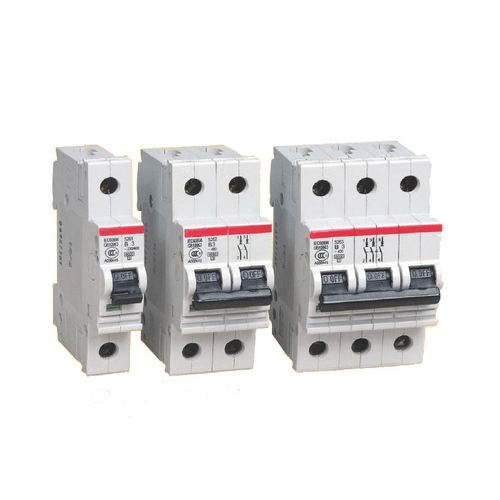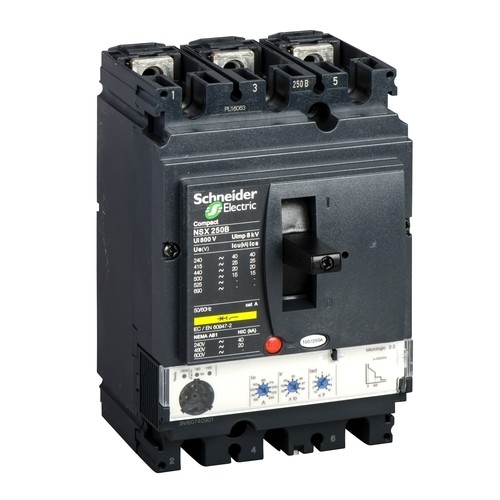التدوينات
Electrical Circuit Breaker

Electrical Circuit Breaker |
Operation and Types of Circuit Breaker
 What is Circuit Breaker?
What is Circuit Breaker?
An electrical circuit breaker is a switching device which can be
operated manually and automatically for controlling
and protecting an electrical power system.
As the modern power system deals with huge currents,
special attention should be given during designing of a circuit breaker to ensure it is able to safely
interrupt the arc produced during the closing of a circuit breaker.
This was the basic definition of circuit breaker.
Introduction to Circuit Breaker
The modern power system deals with huge power network and huge numbers of associated electrical equipment.
During a short circuit fault or any other type of electrical fault (such as electric cable faults),
a high fault current will flow through this equipment as well as the power network itself.
This high current may damage the equipment and networks permanently.
For saving these pieces of equipment and the power networks,
the fault current should be cleared from the system as quickly as possible.
Again after the fault is removed,
the system must come to its normal working condition as soon
as possible for supplying reliable quality power to the receiving ends.
In addition to that for proper controlling of the power system,
different switching operations are required to be performed.
So for timely disconnecting and reconnecting different parts of power system network for protection and control,
there must be some special type of switching devices which can be operated safely under huge current carrying condition.
During the interruption of large current,
there would be large arcing in between switching contacts,
so care should be taken to quench these arcs in circuit breaker in a safe manner.
The circuit breaker is the special device which does all the required switching operations during current carrying condition.
This was the basic introduction to circuit breaker.
Working Principle of Circuit Breaker
The circuit breaker mainly consists of fixed contacts and moving contacts.
In normal “ON” condition of the circuit breaker,
these two contacts are physically connected to each other due to applied mechanical pressure on the moving contacts.
There is an arrangement stored potential energy in the operating mechanism of circuit breaker
which is released if the switching signal is given to the breaker.
The potential energy can be stored in the circuit breaker by different ways like by deforming metal spring,
by compressed air, or by hydraulic pressure. But whatever the source of potential energy,
it must be released during operation.
The release of potential energy makes the sliding of the moving contact in a speedy manner.

whenever these coils are energized by switching pulse,
and the plunger inside them displaced.
This operating coil plunger is typically attached to the operating mechanism of circuit breaker,
as a result the mechanically stored potential energy in the breaker mechanism is released in forms of kinetic energy,
which makes the moving contact to move as these moving contacts mechanically
attached through a gear lever arrangement with the operating mechanism.
After a cycle of operation of circuit breaker the total stored energy is released
and hence the potential energy again stored in the operating mechanism of the circuit breaker
using spring charging motor or air compressor or by any other means.
Till now we have discussed mechanical working principle of circuit breaker.
But there are electrical characteristics of a circuit breaker which also should be considered in
this discussion of the operation of the circuit breaker.
Let’s have a discussion on electrical principle of circuit breaker.
The circuit breaker has to carry large rated or fault power.
Due to this large power, there is always dangerously high arcing between moving contacts
and fixed contact during operation of the circuit breaker.
Again as we discussed earlier the arc in circuit breaker can be quenching safely
if the dielectric strength between the current carrying contacts of circuit breaker
increases rapidly during every current zero crossing of the alternating current.
The dielectric strength of the media in between contacts can be increased in numbers of ways,
like by compressing the ionized arcing media since compressing accelerates the deionization process of the media,
by cooling the arcing media since cooling increase the resistance of arcing path or by replacing the ionized
arcing media with fresh gasses. Hence some arc quenching processes should be involved in the operation of the circuit breaker.
Although circuit breakers perform their function independently and without supervision,
there are also remote control circuit breakers which can be operated on demand at a distance.
 Types of Circuit Breaker
Types of Circuit Breaker
According different criteria there are different types of circuit breaker.
According to their arc quenching media the circuit breaker can be categorized as:
- Oil circuit breaker.
- Air circuit breaker.
- SF6 circuit breaker.
- Vacuum circuit breaker.
According to their services the circuit breaker can be categorized as:
- Outdoor circuit breaker.
- Indoor breaker.
According to the operating mechanism of circuit breaker they can be categorized as:
- Spring operated circuit breaker.
- Pneumatic circuit breaker.
- Hydraulic circuit breaker.
According to the voltage level of installation types of circuit breaker are referred as-
- High voltage circuit breaker.
- Medium voltage circuit breaker.
- Low voltage circuit breaker.

يسعدنا زيارتكم صفحاتنا على مواقع التواصل الاجتماعي حيث نقوم بنشر عروض حصرية على موقعنا الالكتروني.
صفحتنا علي الفيسبوك هنا.
حسابنا على تويتر هنا.
Electrical Circuit Breaker

Electrical Circuit Breaker |
Operation and Types of Circuit Breaker
 What is Circuit Breaker?
What is Circuit Breaker?
An electrical circuit breaker is a switching device which can be
operated manually and automatically for controlling
and protecting an electrical power system.
As the modern power system deals with huge currents,
special attention should be given during designing of a circuit breaker to ensure it is able to safely
interrupt the arc produced during the closing of a circuit breaker.
This was the basic definition of circuit breaker.
Introduction to Circuit Breaker
The modern power system deals with huge power network and huge numbers of associated electrical equipment.
During a short circuit fault or any other type of electrical fault (such as electric cable faults),
a high fault current will flow through this equipment as well as the power network itself.
This high current may damage the equipment and networks permanently.
For saving these pieces of equipment and the power networks,
the fault current should be cleared from the system as quickly as possible.
Again after the fault is removed,
the system must come to its normal working condition as soon
as possible for supplying reliable quality power to the receiving ends.
In addition to that for proper controlling of the power system,
different switching operations are required to be performed.
So for timely disconnecting and reconnecting different parts of power system network for protection and control,
there must be some special type of switching devices which can be operated safely under huge current carrying condition.
During the interruption of large current,
there would be large arcing in between switching contacts,
so care should be taken to quench these arcs in circuit breaker in a safe manner.
The circuit breaker is the special device which does all the required switching operations during current carrying condition.
This was the basic introduction to circuit breaker.
Working Principle of Circuit Breaker
The circuit breaker mainly consists of fixed contacts and moving contacts.
In normal “ON” condition of the circuit breaker,
these two contacts are physically connected to each other due to applied mechanical pressure on the moving contacts.
There is an arrangement stored potential energy in the operating mechanism of circuit breaker
which is released if the switching signal is given to the breaker.
The potential energy can be stored in the circuit breaker by different ways like by deforming metal spring,
by compressed air, or by hydraulic pressure. But whatever the source of potential energy,
it must be released during operation.
The release of potential energy makes the sliding of the moving contact in a speedy manner.

whenever these coils are energized by switching pulse,
and the plunger inside them displaced.
This operating coil plunger is typically attached to the operating mechanism of circuit breaker,
as a result the mechanically stored potential energy in the breaker mechanism is released in forms of kinetic energy,
which makes the moving contact to move as these moving contacts mechanically
attached through a gear lever arrangement with the operating mechanism.
After a cycle of operation of circuit breaker the total stored energy is released
and hence the potential energy again stored in the operating mechanism of the circuit breaker
using spring charging motor or air compressor or by any other means.
Till now we have discussed mechanical working principle of circuit breaker.
But there are electrical characteristics of a circuit breaker which also should be considered in
this discussion of the operation of the circuit breaker.
Let’s have a discussion on electrical principle of circuit breaker.
The circuit breaker has to carry large rated or fault power.
Due to this large power, there is always dangerously high arcing between moving contacts
and fixed contact during operation of the circuit breaker.
Again as we discussed earlier the arc in circuit breaker can be quenching safely
if the dielectric strength between the current carrying contacts of circuit breaker
increases rapidly during every current zero crossing of the alternating current.
The dielectric strength of the media in between contacts can be increased in numbers of ways,
like by compressing the ionized arcing media since compressing accelerates the deionization process of the media,
by cooling the arcing media since cooling increase the resistance of arcing path or by replacing the ionized
arcing media with fresh gasses. Hence some arc quenching processes should be involved in the operation of the circuit breaker.
Although circuit breakers perform their function independently and without supervision,
there are also remote control circuit breakers which can be operated on demand at a distance.
 Types of Circuit Breaker
Types of Circuit Breaker
According different criteria there are different types of circuit breaker.
According to their arc quenching media the circuit breaker can be categorized as:
- Oil circuit breaker.
- Air circuit breaker.
- SF6 circuit breaker.
- Vacuum circuit breaker.
According to their services the circuit breaker can be categorized as:
- Outdoor circuit breaker.
- Indoor breaker.
According to the operating mechanism of circuit breaker they can be categorized as:
- Spring operated circuit breaker.
- Pneumatic circuit breaker.
- Hydraulic circuit breaker.
According to the voltage level of installation types of circuit breaker are referred as-
- High voltage circuit breaker.
- Medium voltage circuit breaker.
- Low voltage circuit breaker.

يسعدنا زيارتكم صفحاتنا على مواقع التواصل الاجتماعي حيث نقوم بنشر عروض حصرية على موقعنا الالكتروني.
صفحتنا علي الفيسبوك هنا.
حسابنا على تويتر هنا.
Leave a Reply
You must be logged in to post a comment.
 What is
What is 






